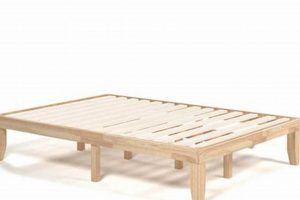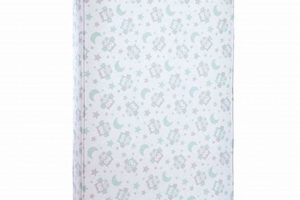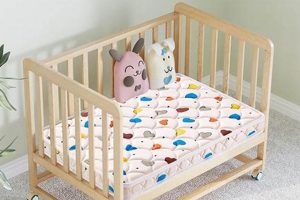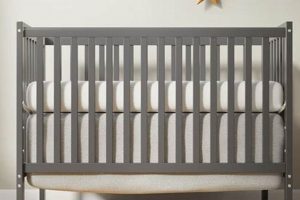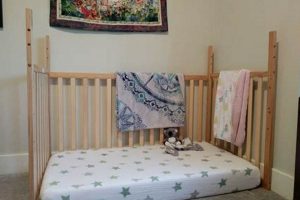The query of whether a standard-sized sleeping surface designed for a crib can be used inside a portable playard is a common concern for caregivers. Playards, also known as pack and plays, are often used as temporary sleeping spaces for infants and toddlers. Standard crib mattresses are designed to fit snugly within the dimensions of a standard crib frame, providing a safe and supportive sleeping environment.
Understanding the dimensional differences between the two types of infant equipment is critical for ensuring child safety. Attempting to force a larger mattress into a smaller space can create gaps around the perimeter, posing a suffocation risk. Furthermore, the intended structural integrity of the playard may be compromised by the use of a non-compatible mattress. The potential hazards associated with improper mattress fit necessitate careful consideration.
This article will explore the specific dimensional variations between these products and outline the safety considerations paramount when selecting a sleeping surface for a playard. Furthermore, it will clarify the recommended guidelines for mattress usage within these portable enclosures to promote safe sleep practices.
Tips Regarding Mattress Compatibility in Portable Playards
The following recommendations address the crucial issue of ensuring a safe sleeping environment when utilizing a portable playard.
Tip 1: Consult Product Manuals: Always refer to the manufacturer’s instructions for both the playard and the mattress. These manuals provide specific guidelines regarding compatible mattress dimensions and recommended usage.
Tip 2: Measure Interior Dimensions: Accurately measure the interior dimensions of the playard’s sleeping area. Compare these measurements with the dimensions of any mattress considered for use within the playard. Discrepancies in size indicate incompatibility.
Tip 3: Prioritize a Snug Fit: The mattress, specifically designed for the playard, should fit snugly within the playard’s frame. Gaps exceeding recommended allowances between the mattress edges and the playard’s sides can pose a hazard.
Tip 4: Avoid Alterations: Modifying a mattress to force a fit into a playard is not advisable. Alterations can compromise the mattress’s structural integrity and increase the risk of suffocation or entrapment.
Tip 5: Verify Mattress Firmness: The mattress should provide adequate firmness to prevent indentation or conformity around the infant’s face. A soft mattress increases the risk of suffocation. Always ensure the mattress meets safety standards for firmness.
Tip 6: Utilize Manufacturer-Approved Mattresses: Whenever possible, use only the mattress that was originally designed and approved by the playard’s manufacturer. These mattresses are specifically engineered to meet the safety requirements of the particular playard model.
Adhering to these tips is crucial for mitigating potential safety hazards associated with the use of non-compatible mattresses in portable playards. The safety and well-being of the infant must be the foremost consideration.
These guidelines are a critical component in promoting infant safety. Further considerations regarding sleep practices will be addressed in the following sections.
1. Dimensions
The primary determinant of whether a crib mattress is suitable for use within a playard rests upon dimensional compatibility. Standard crib mattresses are manufactured according to specified dimensions intended for secure fitting within a traditional crib frame. Playards, conversely, adhere to their own dimensional standards, often smaller than those of standard cribs. Consequently, a crib mattress rarely, if ever, fits properly within a playard.
Dimensional incompatibility presents significant safety risks. A crib mattress forced into a playard can create gaps between the mattress edge and the playard walls. These gaps pose a potential entrapment hazard for infants, increasing the risk of suffocation. Furthermore, an improperly sized mattress can compromise the structural integrity of the playard, potentially leading to instability or collapse. Real-world examples demonstrate tragic consequences arising from using mattresses of incorrect dimensions within infant sleeping environments.
Accurate measurement of both the mattress and the interior of the playard is therefore essential. Discrepancies beyond minimal tolerances dictate incompatibility. Compliance with manufacturer-recommended dimensions for playard mattresses is crucial for ensuring a safe and secure sleeping environment for the child. Deviating from these guidelines introduces unnecessary and potentially life-threatening risks.
2. Safety Standards
The utilization of a crib mattress within a playard necessitates stringent adherence to established safety standards. Crib mattresses and playard mattresses are subject to distinct regulatory requirements and testing protocols. These differences are predicated on the intended use and structural design of each product. Employing a crib mattress in a playard fundamentally deviates from the manufacturer’s intended use and safety testing parameters for both items.
The application of inappropriate bedding can compromise the safety features inherent in a properly assembled and utilized playard. For instance, Consumer Product Safety Commission (CPSC) regulations mandate specific mattress firmness levels to mitigate suffocation risks. A crib mattress, while compliant with crib standards, might not meet the equivalent firmness requirements when placed within the confines of a playard. This discrepancy can create an unsafe sleeping surface, increasing the likelihood of infant asphyxiation. Case studies involving injuries and fatalities related to non-compliant bedding underscore the critical importance of adhering to specified safety standards.
In conclusion, employing a non-compatible mattress introduces a cascade of potential hazards stemming from non-compliance with established safety standards. Prioritizing adherence to manufacturer guidelines and utilizing only approved mattresses for each respective sleeping environment remains paramount. Such vigilance safeguards infant well-being and minimizes the risk of preventable injury or death.
3. Firmness Requirements
Mattress firmness is a critical safety parameter in infant sleep environments. The relationship between mattress firmness and the question of whether a standard-sized crib mattress can be safely used within a portable playard necessitates careful examination. Inadequate mattress firmness contributes significantly to the risk of Sudden Infant Death Syndrome (SIDS) and other sleep-related fatalities.
- Preventing Infant Suffocation
Excessively soft mattresses can conform to an infant’s face, obstructing airways and leading to suffocation. Standards mandate a minimum firmness level to mitigate this risk. If a standard crib mattress is placed into a playard and doesn’t provide the appropriate firmness relative to the playard’s dimensions, it can create an unsafe sleeping surface. Real-world examples demonstrate infants becoming entrapped in soft bedding, leading to tragic outcomes. Therefore, if a crib mattress does not meet the firmness requirements within the spatial constraints of the playard, it is categorically unsuitable for use.
- Meeting Regulatory Standards
Regulatory bodies such as the Consumer Product Safety Commission (CPSC) establish specific firmness standards for infant mattresses. These standards dictate the degree of resistance the mattress must offer to compression. A crib mattress designed to meet crib-specific standards might not satisfy the firmness requirements when used in a playard. Variations in playard design and intended mattress support necessitate differing firmness levels to ensure infant safety. Non-compliance with these regulations can expose caregivers to legal liability and, more importantly, jeopardize infant well-being.
- Ensuring Proper Spinal Support
While primarily a safety concern, adequate mattress firmness also plays a role in providing proper spinal support for the developing infant. A mattress that is too soft can lead to improper spinal alignment, potentially contributing to musculoskeletal issues. Although less immediate than the risk of suffocation, ensuring adequate support is a critical consideration. If a crib mattress, even if it were to fit dimensionally into a playard, lacks the necessary firmness to support the infant’s spine within that configuration, it is inappropriate.
- Considerations for Modified Playards
Some caregivers may consider modifications to a playard, such as adding additional padding or layering blankets to compensate for perceived lack of comfort. However, these modifications introduce significant safety risks by altering the intended firmness of the sleeping surface. These additions can create an overly soft and hazardous environment. A crib mattress used in conjunction with such modifications exacerbates the problem, potentially rendering the sleeping surface even more dangerous. Under no circumstances should unapproved modifications or additions be made to a playard’s sleeping surface to accommodate a crib mattress or enhance perceived comfort.
The interplay between mattress firmness and the use of a standard crib mattress within a portable playard underscores the paramount importance of adhering to manufacturer guidelines and safety standards. The primary objective remains the prevention of infant suffocation and the promotion of safe sleep practices. Any deviation from recommended mattress types and firmness levels introduces unacceptable risks. The use of a crib mattress in a pack and play should only occur if it meets the firmness levels, regulatory and safety standards that intended for the playard.
4. Playard's Intended Use
The fundamental design and intended purpose of a playard are intrinsically linked to the question of mattress compatibility. Playards, also referred to as pack ‘n plays, are engineered as portable, multi-functional units designed for both play and temporary sleep environments. Consequently, playard mattresses are specifically chosen and designed by the manufacturer to conform to the unit’s dimensions, structural design, and safety requirements. The manufacturer develops mattresses based on the intended use and playard design. Utilizing a crib mattress, which is designed for a different and distinct purpose (i.e., use in a standard crib), undermines the engineering intended for the playard.
A critical aspect of a playard’s design is its portability. The inclusion of a larger, heavier crib mattress defeats this primary feature, rendering the playard cumbersome and difficult to transport. Furthermore, playards are designed with shallower sides compared to cribs, with the dimensions and mattress pairing meant to provide proper support and prevent falls. Employing a thicker crib mattress may raise the sleeping surface to an unsafe height, increasing the likelihood of an infant climbing out or falling over the side. Several documented cases involve injuries sustained when children climbed out of playards after a non-standard mattress was used. Therefore, the intended function of easy portability and safety is compromised when a crib mattress is used.
In summary, the compatibility question is directly linked to adhering to the playard’s intended use as a portable and safe environment. Diverting from the manufacturer’s specified mattress voids the safety testing and engineering design, and it should be avoided to prevent unnecessary risks. Prioritizing safety and the playard’s intended portability are crucial considerations for caregivers.
5. Suffocation Risk
The issue of whether a crib mattress will fit inside a playard is directly associated with a significant suffocation risk. A primary concern arises when a mattress not specifically designed for the playard’s dimensions is forced into the space. This often creates gaps between the mattress and the playard’s sides. Infants can become entrapped in these gaps, leading to airway obstruction and subsequent suffocation. The risk is amplified for newborns and young infants who lack the motor skills to free themselves from such entrapment.
Furthermore, the composition of the mattress itself contributes to the suffocation risk. Mattresses not intended for playards may possess excessive softness, potentially conforming to an infant’s face and obstructing breathing passages. Regulatory bodies and safety organizations establish firmness standards to minimize this hazard. The utilization of a non-compliant mattress circumvents these safety measures, increasing the likelihood of suffocation. Documented instances of infant deaths attributed to improper bedding underscore the severity of this concern, highlighting the importance of selecting mattresses engineered explicitly for playard use.
The consequences of neglecting the dimensional compatibility and firmness requirements extend beyond immediate suffocation hazards. Sublethal incidents involving airway compromise can result in neurological damage due to oxygen deprivation. Therefore, understanding the interconnectedness of mattress fit, mattress composition, and suffocation risk is vital for safeguarding infant well-being. Adhering to manufacturer guidelines, verifying mattress firmness, and ensuring proper fit are crucial steps in mitigating potential sleep-related fatalities within playards.
6. Manufacturer Guidelines
Adherence to manufacturer guidelines constitutes a critical element in determining the suitability of a crib mattress for use within a playard. Manufacturers conduct extensive testing and engineering to ensure the playard’s structural integrity and safety performance when used with specific, approved mattresses. These guidelines stipulate precise dimensional requirements, material composition, and firmness levels intended to mitigate known hazards, such as suffocation and entrapment. Deviation from these guidelines introduces potential risks not accounted for in the manufacturer’s safety assessments. For instance, if a manufacturer specifies a mattress thickness of no more than two inches, exceeding this limit with a thicker crib mattress could compromise the playard’s side rail height, increasing the likelihood of a child climbing out or falling. Conversely, a crib mattress that doesn’t fit may create a gap, where the baby’s limbs or head can be stuck.
Manufacturer guidelines are not merely suggestions; they represent the culmination of rigorous safety evaluations. Often, these evaluations are conducted in compliance with or exceeding the requirements of regulatory bodies such as the Consumer Product Safety Commission (CPSC). Disregarding these guidelines can void product warranties and expose caregivers to potential legal liabilities in the event of injury or fatality. Consider, for example, a scenario where a caregiver uses a crib mattress in a playard against the manufacturer’s explicit warnings, and the child subsequently suffocates due to entrapment. In such cases, the manufacturer bears no responsibility, and the caregiver may face legal repercussions for negligence.
Therefore, before considering the use of any mattress other than the one expressly approved by the playard manufacturer, caregivers should meticulously review the product manual and heed all warnings and recommendations. Understanding the rationale behind these guidelinesnamely, the preservation of infant safetyis paramount. The perceived convenience or cost savings associated with using an unapproved mattress should never outweigh the potential risks involved. Manufacturer guidelines serves as safety rules for safe use, it should be properly followed.
7. Structural Integrity
The question of whether a crib mattress is appropriate for use within a playard directly impacts the structural integrity of the playard. Playards are engineered to withstand specific weight distribution and stress levels based on the manufacturer-approved mattress. Introducing a non-compatible mattress can compromise this design, potentially leading to instability or even failure of the playard frame. For instance, a crib mattress may exert undue pressure on the playard’s side rails, causing them to bow outwards or weaken over time. This distortion not only reduces the playard’s stability but also creates potential escape routes for the child, increasing the risk of falls.
The structural integrity is maintained by the size and weight designed. The weight and balance design is only maintained with a properly installed approved mattress. A real-world example illustrates this point: reports have emerged of playards collapsing under the weight of a crib mattress, resulting in injuries to the child. Furthermore, the playard’s locking mechanisms may become compromised, rendering the unit unsafe for use. The practical significance of this understanding lies in recognizing that a seemingly minor deviation from manufacturer specifications can have cascading effects on the overall safety and functionality of the playard.
In summary, the structural integrity of a playard is intricately linked to the use of an approved mattress. Introducing a crib mattress can disrupt this delicate balance, potentially leading to instability, component failure, and increased risk of injury. Prioritizing adherence to manufacturer guidelines regarding mattress selection is paramount to ensuring the continued safety and functionality of the playard. The goal of a safe sleeping environment is achieved through proper care, proper choice, and following provided guidelines from the playard manufacturer.
Frequently Asked Questions
The following section addresses common inquiries regarding mattress compatibility within portable playards, emphasizing safe sleep practices.
Question 1: Is it safe to use a crib mattress in a playard if it seems to fit?
Even if a crib mattress appears to fit within a playard, its use is not recommended unless explicitly approved by the playard manufacturer. Dimensional compatibility alone does not guarantee safety, as differences in firmness, material composition, and overall structural design can pose hazards.
Question 2: What are the potential dangers of using a non-compatible mattress in a playard?
Potential dangers include increased risk of suffocation due to gaps between the mattress and playard sides, entrapment, compromised structural integrity of the playard, and non-compliance with safety standards for infant sleep environments.
Question 3: Where can information about the right mattress for a playard be found?
Information regarding the appropriate mattress for a specific playard model can be found in the product’s instruction manual, on the manufacturer’s website, or by contacting the manufacturer directly.
Question 4: Can a playard mattress be placed on top of a crib mattress inside the playard to make it softer?
Stacking mattresses within a playard is strongly discouraged. This practice creates an unstable sleep surface and increases the risk of suffocation. Playard mattresses must be used independently, without additional padding or layering.
Question 5: Are there specific regulations governing playard mattress dimensions and firmness?
Yes, regulatory bodies such as the Consumer Product Safety Commission (CPSC) establish standards for playard mattress dimensions and firmness to ensure infant safety. Compliance with these standards is essential for minimizing sleep-related risks.
Question 6: What steps should be taken if the original playard mattress is lost or damaged?
If the original playard mattress is lost or damaged, a replacement mattress should be obtained directly from the manufacturer or a reputable retailer, ensuring that the replacement meets all specified safety requirements and dimensional specifications for the playard model.
Adherence to these guidelines is paramount for safeguarding infant well-being and promoting safe sleep practices within portable playards.
The next section offers a comprehensive conclusion that recap the article.
Conclusion
The investigation into whether a crib mattress will fit in a pack and play reveals significant safety concerns related to dimensional incompatibility, compromised structural integrity, and non-compliance with established safety standards. The assessment underscores that standard crib mattresses are generally not designed for use within portable playards due to differing dimensions and firmness requirements. Utilizing a non-compatible mattress increases the risk of infant suffocation, entrapment, and injury. Adherence to manufacturer guidelines, verification of mattress firmness, and ensuring a secure fit are essential for mitigating these hazards.
The decision regarding the appropriate sleeping surface for an infant’s playard demands careful consideration and a commitment to prioritizing safety above all else. Caregivers must remain vigilant in adhering to manufacturer recommendations and established safety protocols to foster a secure and healthy sleep environment. Ongoing awareness and education are crucial in preventing sleep-related incidents and ensuring the well-being of infants within portable playards.


